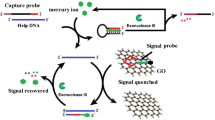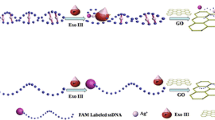Abstract
The authors describe a fluorometric assay for the determination of Hg(II). A naphthalimide derivative is used as a label for a thymine (T) rich ssDNA, and graphene oxide magnetized with Fe3O4 nanoparticles acts as a quencher and preconcentrators. In the absence of Hg(II), the labeled ssDNA does not separate from the magnetized graphene oxide. As a result, fluorescence is fully quenched. In the presence of Hg(II), a T-Hg(II)-T link is formed dues to the highly affinity between T and Hg(II). Hence, fluorescence is restored. The assay has a linear response in the 1.0 to 10.0 nM Hg(II) concentration range, and a 0.65 nM detection limit. The method is selective and sensitive. It was applied to the analysis of spiked environmental water samples, and data agreed well with those obtained by atomic fluorescence spectrometry.

Strategy of a fluorescent probe for detecting Hg(II). The method has a 0.65 nM detection limit and is selective. MGO: magnetized graphene oxide, AHN: a fluorescent derivative of naphthalimide.



Similar content being viewed by others
References
Wiatrowski HA, Ward PM, Barkay T (2006) Novel reduction of mercury(II) by mercury-sensitive dissimilatory metal reducing bacteria. Environ Sci Technol 40(21):6690–6696
Ali RT, Dilek C, Ozcan Y (2013) Preconcentration, speciation, and determination of mercury by solid phase extraction with cold vapor atomic absorption spectrometry. Anal Lett 46(7):1155–1170
Drennan-Harris LR, Wongwilawan S, Tyson JF (2013) Trace determination of total mercury in rice by conventional inductively coupled plasma mass spectrometry. J Anal At Spectrom 28(2):259–265
Huang DW, Niu CG, Ruan M, Wang XY, Zeng GM, Deng CH (2013) Highly sensitive strategy for Hg(II) detection in environmental water samples using long lifetime fluorescence quantum dots and gold nanoparticles. Environ Sci Technol 47(9):4392–4398
Lv XX, Wu WC, Niu CG, Huang DW, Wang CY, Zhang XG (2016) A facile “turn-on” fluorescent method with high sensitivity for Hg(II) detection using magnetic Fe3O4 nanoparticles and hybridization chain reactions. Talanta 15:62–67
Zhou N, Chen H, Li JH, Chen LX (2013) Highly sensitive and selective voltammetric detection of mercury(II) using an ITO electrode modified with 5-methyl-2-thiouracil, graphene oxide and gold nanoparticles. Microchim Acta 180(5–6):493–499
Huang DW, Niu CG, Wang XY, Lv XX, Zeng GM (2013) “Turn-on” fluorescent sensor for Hg(II) based on single-stranded DNA functionalized Mn:CdS/ZnS quantum dots and gold nanoparticles by time-gated mode. Anal Chem 85(2):1164–1170
Hao YL, Guo QQ, Wu HY, Guo LQ, Zhong LS, Wang J, Lin TR, Fu FF, Chen GN (2014) Amplified colorimetric detection of mercuricions through autonomous assembly of G-quadruplex DNAzyme nanowires. Biosens Bioelectron 52(4):261–264
Huang X, Hao Y, Wu H, Guo Q, Guo L, Wang J (2014) Magnetic beads based colorimetric detection of mercuric ion. Sensors Actuators B Chem 191(2):600–604
Yuan T, Liu Z, Hu L, Zhang L, Xu G (2011) Label-free supersandwich electrochemiluminescence assay for detection of sub-nanomolar Hg(II). Chem Commun 47(43):11951–11953
Lou X, Zhao T, Liu R, Ma J, Xiao Y (2013) Self-assembled DNA monolayer buffered dynamic ranges of mercuric electrochemical sensor. Anal Chem 85(15):7574–7580
Lv J, Xie S, Cai W, Zhang J, Tang D, Tang Y (2017) Highly effective target converting strategy for ultrasensitive electrochemical assay of Hg(II). Analyst 142:4708–4714
Li T, Dong SJ, Wang EK (2009) Label-free colorimetric detection of aqueous mercury Ion (Hg(II)) using Hg(II)-modulated G-quadruplex-based DNAzymes. Anal Chem 81(6):2144–2149
Zarlaida F, Adlim M (2017) Gold and silver nanoparticles and indicator dyes as active agents in colorimetric spot and strip tests for mercury(II) ions: a review. Microchim Acta 184(1):45–58
Huber J, Leopold K (2016) Nanomaterial-based strategies for enhanced mercury trace analysis in environmental and drinking waters. Trends Anal Chem 80:280–292
Lei HZ, Mi LJ, Zhou XJ, Chen JJ, Hu J, Guo SW, Zhang Y (2011) Adsorption of double-stranded DNA to graphene oxide preventing enzymatic digestion. Nano 3(9):3888–3892
Haun JB, Devaraj NK, Hilderbrand SA, Lee H, Weissleder R (2010) Bioorthogonal chemistry amplifies nanoparticle binding and enhances the sensitivity of cell detection. Nat Nanotechnol 5(9):660–665
Han YT, Li P, Xu YT, Li H, Song ZL, Nie Z, Chen Z, Yao SZ (2015) Fluorescent nanosensor for probing histone acetyltransferase activity based on acetylation protection and magnetic graphitic nanocapsules. Small 11(7):877–885
Huang PJ, Liu JW (2013) Separation of short single- and double-stranded DNA based on their adsorption kinetics difference on graphene oxide. Nano 3(2):221–228
Weng X, Neethirajan S (2017) Aptamer-based fluorometric determination of norovirus using a paper-based microfluidic device. Microchim Acta 184(8):4545–4552
Huang PJ, Kempaiah R, Liu JW (2011) Synergistic pH effect for reversible shuttling aptamer-based biosensors between graphene oxide and target molecules. J Mater Chem 21(25):8991–8993
Yin LY, Lin YX, Jia L (2014) Graphene oxide functionalized magnetic nanoparticles as adsorbents for removal of phthalate esters. Microchim Acta 181(9–10):957–965
Wu M, Kempaiah R, Huang PJ, Maheshwari V, Liu J (2011) Adsorption and desorption of DNA on graphene oxide studied by fluorescently labeled oligonucleotides. Langmuir 27(6):2731–2738
Cao Z, Nandhikonda P, Heagy MD (2009) Highly water-soluble monoboronic acid probes that show optical sensitivity to glucose based on 4-sulfo-1, 8-naphthalic anhydride. J Org Chem 74(9):3544–3546
Niu CG, Guan AL, Zeng GM, Liu YG, Huang GH, Gao PF, Gui XQ (2005) A ratiometric fluorescence halide sensor based on covalently immobilization of quinine and benzothioxanthene. Anal Chim Acta 547(2):221–228
Bartczak D, Kanaras AG (2011) Preparation of Peptide-Functionalized Gold Nanoparticles Using One Pot EDC/Sulfo-NHS Coupling. Langmuir 27(16):10119–10123
Hu LY, Niu CG, Wang XY, Huang DW, Zhang L, Zeng GM (2017) Magnetic separate “turn-on” fluorescent biosensor for bisphenol A based on magnetic oxidation graphene. Talanta 168:196–202
Li M, Zhou X, Ding W, Guo S, Wu N (2016) Fluorescent aptamer-functionalized graphene oxide biosensor for label-free detection of mercury (II). Biosens Bioelectron 41(1):889–893
Niu CG, Qin PZ, Zeng GM, Guo XQ, Guan AL (2007) Fluorescence sensor for water in organic solvents prepared from covalent immobilization of 4-morpholinyl-1, 8-naphthalimide. Anal Bioanal Chem 387(3):1067–1074
Shang J, Ma L, Li J, Ai W, Yu T, Gurzadyan GG (2014) The origin of fluorescence from graphene oxide. Sci Rep 2:792
Li L, Li BX, Qi YY, Jin Y (2009) Label-free aptamer-based colorimetric detection of mercury ions in aqueous media using unmodified gold nanoparticles as colorimetric probe. Anal Bioanal Chem 393:2051–2057
Wang ZX, Guo YX, Ding SN (2015) Fluorometric determination of cadmium(II) and mercury(II) using nanoclusters consisting of a gold-nickel alloy. Microchim Acta 182:2223–2231
Hu TY, Yan X, Na WD, Su XG (2016) Aptamer-based aggregation assay for mercury(II) using gold nanoparticles and fluorescent CdTe quantum dots. Microchim Acta 183:2131–2137
Acknowledgements
This work was financially supported by the National Natural Science Foundation of China (21507034, 51521006), the Natural Science Foundation of Guangdong Province, China (2016A030310022), and the Pearl River S&T Nova Program of Guangzhou (201710010134).
Author information
Authors and Affiliations
Corresponding authors
Ethics declarations
The author(s) declare that they have no competing interests.
Electronic supplementary material
ESM 1
(DOCX 1783 kb)
Rights and permissions
About this article
Cite this article
Li, MK., Hu, LY., Niu, CG. et al. A fluorescent DNA based probe for Hg(II) based on thymine-Hg(II)-thymine interaction and enrichment via magnetized graphene oxide. Microchim Acta 185, 207 (2018). https://doi.org/10.1007/s00604-018-2689-6
Received:
Accepted:
Published:
DOI: https://doi.org/10.1007/s00604-018-2689-6




